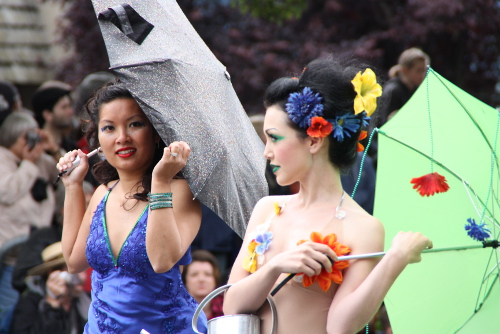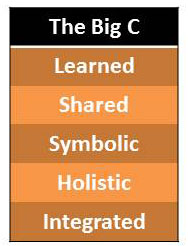Cultural Anthropology/Anth Perspective/Key Concepts
Contents
Key Terms & Concepts
- Culture
- Dominant culture
- Levels of culture
- Ethnocentrism
- Overt and covert culture
- Proxemics
- Worldview
- Culture change: discovery and invention, diffusion, acculturation
- Culture lag
- Values
- Norms: folkways, mores, laws
- Social control
- Social institutions
Anthropological Culture Concept
Culture is a concept that often invokes thoughts of a Monet, a Mozart symphony, or ballerinas in tutus dancing Swan Lake. In the popular vernacular culture often refers to the arts. A person that is cultured has knowledge of and is a patron of the arts. Then there is pop culture; what trends are current and hip. Within anthropology these things are simply aspects of culture. To understand the anthropological culture concept, we need to think broader and holistically.
Anthropologists have long debated an appropriate definition of culture. Even today some anthropologists criticize the culture concept as oversimplifying and stereotyping cultures, which will be discussed more below. The first anthropological definition of culture comes from 19th-century British anthropologist Edward Tylor:
Culture...is that complex whole which includes knowledge, belief, art, law, morals, custom, and any other capabilities and habits acquired by man as a member of society (Tylor 1920 [1871]: 1).
It is probably the most enduring definition of culture even though it relates more to the specifics, or particulars, of culture groups. As Bohannan and Glazer comment in High Points in Anthropology (1988: 62), "...[it is the definition] most anthropologists can quote correctly, and the one they fall back on when others prove too cumbersome." Tylor, echoing the French idea of civilization progressing from a barbaric state to “science, secularism, and rational thought” (Beldo 2010), believed that all human culture passed through stages of development with the pinnacle being that of 19th century England. He believed, as many others of this time period did, that all other cultures were inherently inferior. Franz Boas, a German American anthropologist, challenged Tylor’s approach. He drew on the German concept of kultur, local and personal behaviors and traditions, to develop his ideas about culture. Boas thought that cultures did not follow a linear progression as espoused by cultural evolutionists like Tylor, but developed in different directions based on historical events. Boas took years to develop a working definition of culture, but it is one that influences anthropologists to this day: culture is an integrated system of symbols, ideas and values that should be studied as a working system, an organic whole (Kuper 1999:56).
Over time, anthropologists learned that including specifics into the definition of culture limited that definition. In other words, the definition would not apply to all cultures. Anthropologists began to develop a definition of culture that could be applied broadly. Alfred Kroeber and Clyde Kluckhohn proposed that culture was not simply behaviors, but a product of psychological, social, biological, and material factors (Beldo 2010). Thus began a focus on the meaning of behavior, not just a description of the behavior itself.
A general definition of culture that can be applied to all cultures is patterns of behavior that are common within a particular population of people. One way to think about culture is to break down the concept into two distinct categories: the Big C and the little c. The Big C is an overarching general concept that can be applied to all culture groups; it is the anthropological perspective. The little c is the particulars of a specific culture group.
It is easiest to think of the Big C as elements that comprise culture (not a specific group).
- Big C is learned behavior. Culture is not something we are born with; it is non-biological. We learn it over our lifetime.
- Culture is shared. While we each have our own cultural peculiarities, we share a large part of our culture with others.
- Culture is symbolic. It gives meaning to things. Language might be the most important example of the symbolic nature of culture. Language is one of the primary ways that we communicate with one another.
- Culture is holistic. Ideally, culture is all encompassing. It is a blueprint for living and tells us how to respond in any given situation. Of course in reality, culture doesn’t give us all the answers. That’s when we see culture change.
- Lastly, culture is integrated. Think of it as a clock. Clocks have an intricate mechanical system that work together to make the clock operational. Culture is also a system – a system of institutions that work together to meet the needs of the group.
Little c, as mentioned above, is the particulars of any given culture group, for instance, the marriage or subsistence pattern of a group of people. Traditions, a concept many people associate with culture, would fall into the little c. A good portion of this course is devoted to examining the various manifestations of social institutions, or some of a culture group's particulars, so we will return to the little c later in the course.
Levels of culture
Anthropologists describe patterns of behavior that are common within a particular population of people—a culture. This is sometimes referred to as the dominant or mainstream culture. In using the word dominant, do not confuse this with “majority.” The dominant culture may be a result of political power and not absolute numbers of people. However, the dominant culture draws on other cultures, adding and dropping elements that are seen to be either beneficial or no longer necessary. Within the dominant culture, there are subcultures that vary somewhat from the mainstream. Even at the individual level there may be differences from the dominant culture. Keep in mind that while anthropologists talk about these general patterns, it is acknowledged that there is variation within any given culture.
The levels that are discussed below are a classification system. Classification systems help people organize the plethora of information that comes their way, breaking it down into understandable units. The levels of culture allow us to understand culture in smaller interconnected units.
The overarching patterns described by anthropologists can be grouped at several different levels, which may or may not apply to every culture. The levels move from general to specific. While most people don’t think about their culture at the most general levels, these levels do impact our cultures even if we’re not aware of it. One of the criticisms of the culture concept is that it generalizes and stereotypes groups of people. Indeed as you read about the levels of culture you may agree with this criticism. However, these generalizations can be used to develop a starting point in learning about a culture and should not be used as an evaluative scale.
The Levels
International: this is a geographical level divided into two categories: Western culture and Eastern culture. Historically, the division fell along two lines: religion and industry.
Eastern culture is usually thought of as non-industrial; however, through the process of modern development, this line is less clear than it used to be.
Eastern culture also refers to a different way of thinking, which is best exemplified in the East’s religions such as Buddhism, Hinduism, and Confucianism. Interdependence of people is a defining characteristic of “eastern” philosophy. Duty to family over self is stressed.
The other thing that encapsulates eastern culture is their approach to healing—in the east, it is generally identified as ancient, naturalistic traditions…think acupuncture and herbal remedies.
Western culture arose out of the philosophies of ancient Greece and Rome. Currently it is characterized by industrial economies where capitalism rules and behavior geared for independent success is stressed. Western cultures are predominately Christian or Islamic. In regards to health, institutionally educated doctors and scientifically developed medicines dominate.
There is much variation within Western and Eastern cultures, but think in terms of dominance. Eastern cultures do encourage people to develop their skills; it’s just that it is not for themselves, but for their group (which can be family, village, or some other entity). In western cultures, duty to family is not absent; it’s just not stressed as strongly.
Keep in mind that the East vs. West mentality or approach is rapidly breaking down through the process of globalization. Today, one might find reference to global culture as the breakdown of geographic barriers to knowledge and behavior, particularly as spread via modern media and the internet.
The variability of the international level can be broken down into various subcultures, starting with the most general, the National. Subcultures incorporate values and norms from the more general levels, but perhaps not all of the same values and norms.National: Just as the word implies, we’re talking about a country’s culture. For instance, if someone talks about Ireland, Russia, or Brazil certain mental pictures come to mind. National characteristics can be spread through media, education, and popular culture. However, it is important to acknowledge that the level of buy-in at this level is highly variable. Modern nation state boundaries were designated by colonial powers who ignored ethnic identities. Within the nation state some people identify more with ethnic culture rather than the national culture.
Regional: Nations are frequently divided into regions. If we were to talk about the United States in terms of the South, the Midwest, or the Southwest, we start to make some assumptions about the culture of individuals from those geographic regions, e.g., the Midwest is populated by farmers.
State-level: Within regions, there are often states, provinces, or territories. If we picked a state in the United States, many people would start to form a mental picture of the people there. If we were to choose an east coast state such as Massachusetts we would make some assumptions about the people's forms of dress, speech, etc., that is very different from what would assume if the person was from California.
Local: This level could be along the lines of urban vs. suburban vs. rural or it could be something like Seattle vs. Tacoma. It could be a neighborhood or an occupation. There are a multitude of ways to view the local.
Counter-cultures: Counter-cultures go against something in the mainstream or dominant culture. The classic example of a counter-culture is the hippie/protest movement during the 1960s in the United States. A more recent example is the anti-globalization movement.
The final level of culture, and the most specific, is the idiosyncratic culture. This refers to our personal culture. We are influenced by and choose norms from all of the previous levels of culture to create our personal cultures. Our family and friends are often most influential, but as we mature and move away from home our personal culture may begin to look nothing like the culture we grew up in.
Clearly, all of these levels of cultures are broad generalizations. There is variety of culture in any given place in the world. What these broad generalizations do is provide us with a level of expectations. They help us cope with the unknown. Problems arise when people use these generalizations as a way to judge other peoples. Ethnocentrism, the judging of others using your own culture as the standard, contributes to negative views of The Other and is a way to dehumanize another human being, a necessary step before being able to compete successfully against our fellow humans.
Culture is both overt and covert. There are elements of culture that we are specifically taught--they are overt…how to eat with utensils or how to ride a bicycle. But there are also elements that we are not taught---they are covert and picked up most likely through observation…a good example of this is proxemics. Proxemics refers to our personal bubble---how much space we need around our physical person. In the United States, we have a large personal bubble. We don’t like people to get near to us unless invited. Standing smashed up against someone else on the bus is considered bad manners in the US and is only tolerated if there is absolutely no choice. We aren’t specifically taught this; we pick it up through observation.
We think about our culture, particularly our national culture, in its ideal form. For instance, when asked to describe the values of US culture, people often mention equality, democracy, and freedom. The reality of US culture is that there is not complete equality of citizens and some believe the US only promotes democracy unequally across the globe.
All of these things contribute to our worldview. Worldview is a way of understanding how the world works and what our place is in it. Everyone has a worldview that impacts their perceptions and interpretations of events occurring in their lives. Some people think everyone else interprets or sees things the same way they do. This is referred to as naïve realism. We all start out that way, but through education, our naïve realism lessens as we learn about other people’s perspectives…in effect, our culture is changing.
Culture Change
Cultures change in a number of ways. The only way new cultural traits emerge is through the process of discovery and invention. Someone perceives a need and invents something to meet that need. Seems a simple enough concept; however, it often takes a long time for a new invention to be fully integrated into a culture. Why? Because often other elements of the culture have to change to meet or maintain the needs of the new invention. This is referred to as culture lag. The automobile is a good example of discovery and invention and culture lag. The auto was invented as a mode of more efficient transportation. Many things had to change in order for the automobile to become a fixture in a culture. People had to be persuaded that the automobile was a better form of transportation. Roads had to be constructed; a way to procure fuel needed to be developed; mechanics were needed to fix cars; efficient production of cars had to be developed to meet supply demands; safety concerns, rules of the road, insurance, and numerous other elements of culture had to catch up with the invention of the automobile.Another way cultures change is through diffusion. Diffusion is simply the borrowing of traits. There is a long laundry list of things in US culture that were borrowed from other cultures. Pajamas made their way to the US from India. Spaghetti was borrowed from China by way of Italy, and corn came from Mesoamerica. Ralph Linton, a noted anthropologist, wrote a short article entitled “One Hundred Percent American” in which he outlines numerous things that U.S. culture borrowed from other cultures. Click here to read Linton’s article.
Yet another way cultures change is through the process of acculturation. Acculturation is also the borrowing of traits; however, there is a superordinate, or dominant, and subordinate, or minority, relationship between cultures. The dominant culture picks and chooses those traits from the subordinate culture that it deems useful, i.e., diffusion. The subordinate culture is pressured to adopt the traits of the dominant culture. It is the element of pressure that differentiates acculturation from diffusion.
Acculturation manifests itself in multiple ways. One way is called the Melting Pot. The melting pot refers to a blending of cultures. This primarily occurs through intermarriage of people from the two cultures. What frequently happens is that one of the two cultures is dominant and the other subordinate within the relationship so that only some of its traits are practiced.
Another form of acculturation is called the Salad Bowl, or cultural pluralism. This occurs when people immigrate and keep as many original cultural traits as possible. Chinatown in San Francisco is a good example of the salad bowl. The different types of acculturation are not necessarily mutually exclusive. Even in the case of cultural pluralism people must adopt certain traits of the host country; i.e., the laws, in order to thrive, but they do keep as many traditions as possible.
Host conformity occurs when an individual has fully assimilated into the host culture.
Values & Norms
Values are abstract concepts that certain kinds of behaviors are good, right, ethical, moral and therefore desirable. In the United States, one value is freedom; another is equality.
These values can come from a variety of sub-cultures or social institutions. A society can have all of the values it wants, but if it doesn’t have a way to enforce those values, then having values means nothing.
So societies have developed forms of social control, which is the process people use to maintain order in group life.
There are two main categories of social control: norms and laws. A norm is a standard of behavior. At some point people in the society agree that these are standards. Some people learn by being taught, but mostly we pick them up just by being exposed to them.
There are a couple of types of norms: folkways and mores. Folkways are norms related to everyday life—eating with silverware, getting up in the morning and going to work or school for example. There are also mores, which are behaviors that are right or wrong…don’t kill people, don’t steal…
Some norms are explicitly taught, others are tacit—we pick them up through observation. We pick up forms of greeting, roles, which side of the sidewalk to walk on…the list could go on and on...simply through watching what other people are doing.
Sometimes, particularly in state-level societies, the mores are codified into laws or binding rules. So, stealing as a bad behavior becomes a crime. Murder—crime.
So, how do societies encourage compliance with norms and laws? There are rewards and punishment. For instance, if you kill someone in our society, if you’re caught, you go to trial and if found guilty, you go to prison, or you can be put to death. We have developed specific jobs and organizations that carry out enforcement of laws…police, court system, prison, military. These are official forms of social control. Now these forms don’t have to be negative. Some are positive…a good example would be something like a Citizen Hero award.
There is also informal enforcement of norms and laws. As with the official forms of social control enforcement, the unofficial can be both positive and negative—giving your child an allowance for completing chores is an example of positive enforcement; spanking or time outs are examples of negative enforcement. Peer pressure and religious doctrine are other informal methods of enforcement of both norms and laws. Ostracism, or shunning, is yet another.
However, there are times when norm or even law violations don’t result in punishment, but these types of violations are very specifically defined by a culture. For instance, it is generally accepted that if you kill someone in self-defense or in a time of war, the punishments do not apply.
All of these norms and laws can be organized into a set of social institutions. A social institution is a patterned set of behaviors developed to meet perceived needs. This way people aren’t doing whatever they want whenever they want to meet their needs. In US culture, we treasure independence, but that independence must be exercised within the constructed social institutions. That’s not to say that there aren’t people who go outside of these social constraints, they do. That is actually important behavior in an evolutionary sense as it provides variation of behaviors. It is those behaviors where social change is instigated.
Anthropologists put these patterns of behavior into some general categories, for instance, economic systems, religion, expressive culture, and political organization. The exact pattern varies from group to group, but the needs that are met are pretty much the same.
As we move through the course and read about other cultures, think about the values and norms of your own culture. When you have a reaction, particularly a strong reaction, stop and think about what personal cultural values, norms and laws are being violated. This will help you have a deeper understanding of the material we cover in the course.
Explore: Learn More about the Anthropologists
References
Bohannan, Paul and Mark Glazer. 1988. High Points in Anthropology, 2nd edition. New York: McGraw-Hill, Inc.
Tylor, Edward Burnett. 1920 [1871]. Primitive Culture. New York: J.P. Putnam’s Sons.





